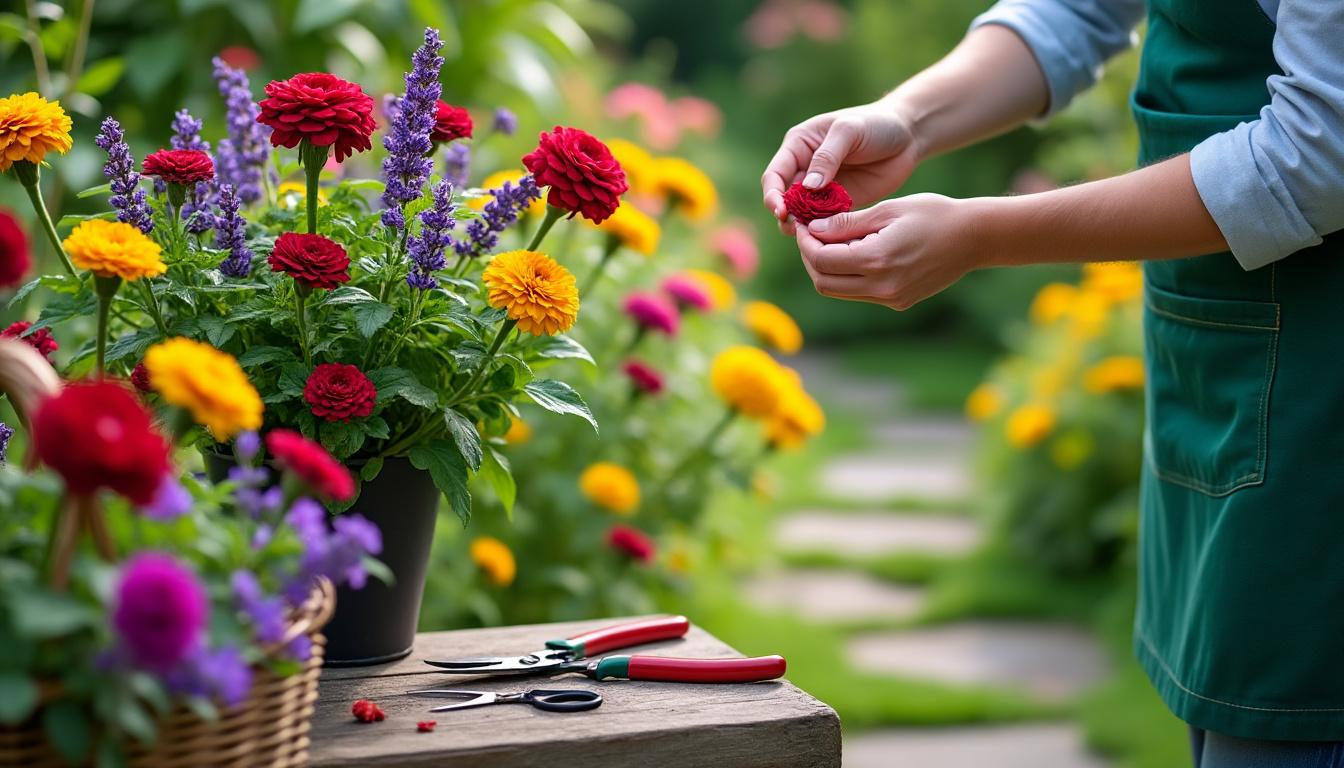Maintaining a garden vibrant with color and health requires dedicated care and precise techniques, among which deadheading stands out as a particularly impactful practice. By removing spent blossoms, gardeners unlock their plants’ full potential, prompting additional flowering cycles and preventing unwanted seed dispersal. Gardening enthusiasts and professionals alike appreciate this method not only for its aesthetic benefits but also for the overall vigor it imparts to flowers. With the aid of industry-leading tools from brands such as Gardena, Fiskars, and Black & Decker, deadheading becomes an accessible and rewarding task, even for beginners. Understanding the science behind deadheading, alongside practical tips and an overview of its significance, equips gardeners to create flourishing landscapes that captivate season after season.
Unlocking the Science of Deadheading: How Removing Spent Flowers Spurs Growth
Deadheading is the horticultural practice of selectively removing faded, wilted, or seed-forming flowers from plants. The rationale behind this process lies in the plant’s natural growth cycle. Once a flower finishes blooming, its energy shifts toward seed production, signaling the end of that blooming phase. By excising the spent flowers before seed formation, gardeners redirect the plant’s energy towards generating new buds and blooms, thereby extending the flowering period significantly.
This redirection of energy is not merely hypothetical; research and practical experience confirm that precise and timely deadheading can increase the longevity and vibrancy of flowers on plants such as hydrangeas, zinnias, and dahlias. For instance, professional gardeners using premium pruning tools like those from Fiskars report more robust flower displays and increased growth vigor in their deadheaded specimens. Not all plants respond the same way — some species naturally shed spent blooms and do not benefit considerably from deadheading, making plant-specific knowledge essential.
Biological Impact of Deadheading on Plants
The removal of spent flowers promotes several physiological advantages for flowering plants:
- Prevention of Seed Formation: By removing the dying flower before seeds set, plants avoid diverting resources to seed maturation.
- Stimulated Bud Growth: Hormonal changes induced by deadheading encourage lateral buds to develop new blossoms.
- Enhanced Airflow and Reduced Disease Risk: Removing dense, fading flower heads improves airflow, decreasing mold and mildew potential.
- Maintained Aesthetic Appeal: Gardens stay tidy and vibrant without drooping, decaying flowers.
To maximize these benefits, selecting the right tools matters significantly. The precision and ergonomics of Garden’s cordless pruners or Black & Decker’s multi-use garden shears help maintain clean cuts, essential for the plant’s health. Deadheading technique also varies by flower type—some blooms should be pinched by hand, while tougher stems require shears.
| Plant Type | Deadheading Requirement | Recommended Tools | Benefits |
|---|---|---|---|
| Hydrangeas | Regular deadheading | Fiskars bypass pruners | Promotes bigger blooms, prevents seed set |
| Zinnias | Frequent deadheading | GardenaComfort pruners | Extends bloom season, keeps plants tidy |
| Peonies | Minimal deadheading | Hand pinch recommended | Maintains shape, prevents mold |
| Roses | Consistent deadheading | Black & Decker garden snips | Encourages reblooming, disease prevention |
Gardening enthusiasts aiming for peak performance should pair their knowledge with reliable products like Scotts plant food or Espoma organic fertilizers, which supply nutrients critical for sustained flowering post-deadheading. For watering efficiency after deadheading, Rain Bird irrigation solutions ensure plants receive adequate moisture without overwatering, further supporting resilient blooms.
Practical Deadheading Tips: Timing, Technique, and Plant-Specific Approaches
Executing deadheading effectively requires attention to timing and method. Deadheading at the optimal moment ensures the plant can refocus its energy before seed development begins. The general rule is to remove flowers as soon as they start wilting and lose their vibrant color but prior to seed pod formation.
Seasonality plays a vital role too. For many perennials and annuals, deadheading throughout the growing season revitalizes the plant repeatedly. Waiting too long can stunt the potential for additional blooms and sometimes even stress the plant. Each species, however, has unique timing needs:
- Dahlias: Deadhead weekly for sustained vibrancy in summer and early fall.
- Hydrangeas: Remove spent blooms after the flowering period ends to encourage larger blossoms later.
- Marigolds: Pinch off old flowers promptly to boost continual flowering.
- Roses: Deadhead regularly to support prolonged blooming phases.
Technique is equally crucial. For softer-stemmed flowers, pinching fleshily below the bloom base is sufficient. Hardy plants with thicker stems require cutting with sharp garden shears, like those from Bully Tools, to prevent ragged edges that may invite disease.
One of the best gardening tips for newcomers is to carry a small hand pruner, perhaps from Fiskars or Gardena, always within reach during routine garden walks. This habit turns deadheading into a natural part of garden maintenance, ensuring plants never languish with exhausted blooms.
| Flower | Best Time to Deadhead | Recommended Technique | Tool Suggestions |
|---|---|---|---|
| Zinnias | Twice weekly in summer | Pinch or cut at base | GardenaComfort pruners |
| Dahlias | Weekly during bloom | Cut with sharp shears | Bully Tools pruners |
| Marigolds | Regularly, as flowers fade | Pinch dead flowers | Hand technique |
| Roses | Every 1–2 weeks | Cut above leaf node | Black & Decker garden snips |
For gardeners interested in extending their knowledge with a broader context of garden care, exploring seasonal preparation articles enhances understanding. Resources such as garden spring preparation and seasonal gardening tips provide valuable insights to optimize plant health alongside deadheading.
Choosing the Right Tools and Supplies to Support Deadheading Excellence
The efficacy of deadheading depends greatly on the equipment used. Gardeners frequently cite Gardena’s range of ergonomic pruners, Fiskars’ renowned precision cutting tools, and the durability of Black & Decker’s garden shears for making the task easier and reducing plant stress.
High-quality tools bring numerous advantages:
- Clean Cuts: Preventing jagged edges reduces chances of infection or pest infiltration.
- Ergonomic Design: Reduces hand strain, encouraging longer and more frequent deadheading sessions.
- Durability: Long-lasting shears minimize replacements and maintain consistent performance.
In addition to sharp cutting implements, gardeners benefit from incorporating nutrient-rich supplements like Miracle-Gro and Espoma organic fertilizers. Such products replenish soil vitality post-pruning and bolster plants’ capacity to produce new flowers swiftly.
Equally critical, tools from brands like Bully Tools help with supporting soil aeration near flower beds after heavy deadheading, indirectly improving nutrient and moisture uptake. Paired with efficient watering systems like Rain Bird, these methods create ideal conditions for flowers to thrive post-maintenance.
Consider the following tool and supply list for optimal deadheading operations:
- Sharp pruning shears (Gardena, Fiskars, Black & Decker)
- Protective gloves for handling thorny or spiky plants
- Garden scissors or snips for delicate flowers
- Organic fertilizers (Espoma, Miracle-Gro)
- Mulching materials or compost for clipping disposal
- Watering systems (Rain Bird drip irrigation)
Deadheading’s Role in Disease Prevention and Garden Aesthetics
Beyond promoting continuous blooms, deadheading contributes decisively to garden health and appearance. Leftover faded flowers can become breeding grounds for fungal diseases such as powdery mildew and botrytis, especially in humid or densely planted gardens.
By routinely removing dead or dying blossoms, gardeners improve air circulation around plants. This airflow is vital in preventing moisture buildup and interrupting the lifecycle of many common plant pathogens.
Moreover, deadheading helps maintain a neat, visually appealing garden space. Overgrown or seed-laden flowers may make plantings appear untidy and reduce overall garden impact. This tidiness also discourages unwanted self-seeding, which can cause invasive or rampant growth of certain species without gardener consent.
| Issue Prevented by Deadheading | Details | Benefits |
|---|---|---|
| Fungal Diseases | Removal of decaying blooms reduces mold habitat | Healthier plants and longer bloom cycles |
| Self-Seeding Control | Prevents unwanted seedlings crowding flower beds | Maintains garden design intentions and aesthetics |
| Tidiness and Visual Appeal | Removing spent flowers keeps garden beds looking fresh | Enhances curb appeal and personal satisfaction |
Combining deadheading with routine maintenance protocols results in thriving, disease-resistant gardens that captivate visitors and ensure sustainability. Tools and products from companies such as Scotts and Vortex also complement these efforts through soil health management and pest deterrence, respectively.
Extended Deadheading Strategies for Advanced Gardeners and Flower Enthusiasts
For gardeners seeking to elevate their practice beyond basic deadheading, several advanced strategies and considerations enrich flower garden vitality:
- Seasonal Deadheading Schedules: Creating a calendar based on plant species bloom cycles ensures continuous care without overworking.
- Selective Pinching Vs. Cutting: Deciding which flowers benefit from selective pinching rather than cutting optimizes plant energy efficiency.
- Integration with Fertilization and Watering: Timing deadheading alongside nutrient application (such as Miracle-Gro) and irrigation management (Rain Bird systems) improves outcomes.
- Composting Deadheaded Material: Proper recycling of plant waste using Espoma-approved composting techniques supports soil health.
Many advanced gardeners reference the expertise of influencers such as Caroline Maurer, who advocates educating on deadheading best practices via digital platforms. Her demonstration videos and engagement with community questions underscore the evolving nature of gardening care in 2025.
The practice also involves addressing specific plant exceptions, as some flowers either refuse to bloom again or generate aesthetically pleasing seed heads that benefit the garden’s biodiversity. Researching species such as peonies or daisies can inform whether deadheading is truly necessary or potentially counterproductive.
| Advanced Deadheading Strategy | Description | Expected Benefit |
|---|---|---|
| Seasonal Scheduling | Mapping bloom cycles to deadheading routine | Optimized bloom frequency and garden efficiency |
| Selective Pinching | Pinching off specific blooms rather than cutting | Increased flower size and extended bloom life |
| Integration with Fertilizer | Applying Miracle-Gro or organic fertilizers post-deadheading | Faster recovery and nutrient uptake |
| Composting Practice | Utilizing Espoma-certified compost for clippings | Improved soil health and sustainability |
Frequently Asked Questions about Deadheading in Gardening
- What is deadheading, and why is it important?
Deadheading is the removal of spent or faded flowers from plants to redirect energy toward new bloom production and maintain garden health.
- Do all flowers require deadheading?
No, not all flowers benefit significantly from deadheading. Research your specific plant species to identify whether deadheading will enhance bloom longevity.
- When is the best time to deadhead flowers?
The ideal time is shortly after flowers begin to wilt but before seed pods develop, varying from weekly to biweekly depending on the plant.
- Which tools are best suited for deadheading?
Ergonomic pruning shears from brands such as Gardena, Fiskars, and Black & Decker provide clean cuts and reduce hand fatigue.
- How should deadheading clippings be disposed of?
Clippings can be composted, mulched directly in the garden if disease-free, or discarded to prevent fungal spread.

